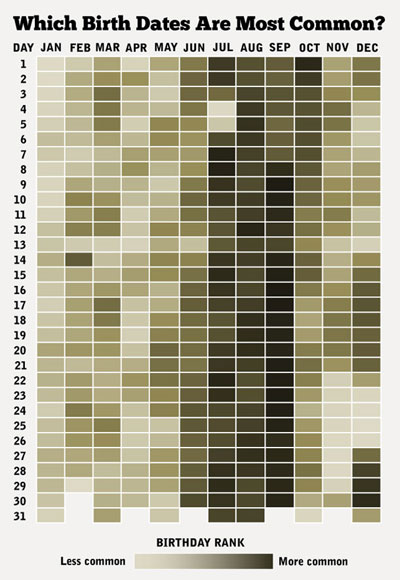
Divorce lawyers and wedding planners have been gearing up for the Facebook IPO, waiting for the influx of wealth in Silicon Valley to stir up drama in romantic relationships, for better and for worse.
“When Google went public, there was a wave of divorces. When Cisco went public there was a wave of divorces,” says Steve Cone, a divorce attorney based in Palo Alto, near the social network’s Menlo Park headquarters. “I expect a similar wave shortly after Facebook goes public.”
{ FT | Continue reading }
photo { Vivian Maier }
economics, law, relationships |
May 19th, 2012
eyes, visual design |
May 19th, 2012

{ A human brain overrun with cysts from Taenia solium, a tapeworm that normally inhabits the muscles of pigs. | Discover | full story }
brain, gross, health |
May 19th, 2012

Meeting new people can be a delicate business. How do you make sure that people get a right impression of who you are and what you’re capable of? Many people therefore tend to keep things formal and are hesitant to brag about themselves. But recent research in the Journal for Social Psychological and Personality Science reveals that it is wise to actually show your best self when meeting new people. At least, when you want them to really get to know you.
{ United Academics | Continue reading }
Neuroscientists at NYU and Harvard have identified the neural systems involved in forming first impressions of others. […] Making sense of others in a social interaction is not easy—each new person we meet may be a source of ambiguous and complex information. However, when encountering someone for the first time, we are often quick to judge whether we like that person or not. In fact, previous research has shown that people make relatively accurate and persistent evaluations based on rapid observations of even less than half a minute.
{ eScienceNews | Continue reading }
related { Why First Impressions Are So Persistent }
painting { Marcus Harvey, Girl in Burka with Red Underwear II, 2007 }
guide, neurosciences, psychology, relationships |
May 18th, 2012

{ Why do some people enjoy the taste of broccoli while others find it bitter and unpleasant? Why do some seek out spicy and tangy meals on a restaurant’s menu while others stick with the bland and familiar? New research is uncovering the neurobiological and genetic sources of taste preferences, which can influence not just eating habits but also health. | Brain Facts | full story }
brain, food, drinks, restaurants, health, science |
May 18th, 2012

A good memory is typically seen as a powerful advantage, an aid to intelligence and socializing. But when experience is traumatic, this asset may become a serious liability, according to new research on survivors of the Rwandan genocide.
Researchers at the University of Basel in Switzerland studied a gene for a protein called PKCA, which is known to be involved in the encoding of emotional memories. […]
According to the study, the findings point to a “genetic link between the predisposition to build strong memory and the risk for post-traumatic stress disorder.”
The research also adds to increasing evidence that many “positive” genes also have a downside — and similarly, many “negative” ones have an upside. For example, one gene linked with a tendency for children to share treats with others is also linked to ADHD and later in life, promiscuity and addiction.
{ Time | Continue reading }
photo { Juergen Teller }
genes, memory |
May 18th, 2012

{ This surgeon has performed 200 penis enlargement operations in the last year alone. But are men getting what they pay for? | Independent | full story }
health, sex-oriented |
May 17th, 2012

One of the nightmare scenarios for modern society is the possibility of a global flu pandemic like the 1918 Spanish influenza which infected about a quarter of the global population and killed as many as 130 million of them.
An important question for policy makers is how best to limit the spread of such a disease if a new outbreak were to occur. (The Spanish flu was caused by the H1N1 flu virus that was also responsible for the 2009 swine flu outbreak.)
One obvious idea is to close international airports to prevent, or at least dramatically reduce, the movement of potentially infected individuals between countries. But is this the best approach?
Today, Jose Marcelino and Marcus Kaiser at Newcastle University in the UK, provide an answer. They say a better approach is to cut specific flights between airports because it can achieve the same reduction in the spread of the disease with far less drastic action.
{ The Physics arXiv Blog | Continue reading }
airports and planes, health, incidents, science, within the world |
May 17th, 2012

Ancient philosophy - especially after Aristotle - largely focused on how to achieve self-sufficiency on the one hand, and peace of mind on the other; it thus became fundamentally therapeutic, in nature and goal. Though ancient philosophers are generally known for their praise of friendship, there is an evident tension involved in these positions: the possession of friends seems almost unhelpful, nearly inimical, to self-sufficiency and peace of mind. As fulfilling as friendships generally are, they often lead to mutual dependency and a loss of the tranquility thought to accompany solitude. The problems grow even more acute when one considers other, more intimate forms of human relationships, those celebrated less widely in ancient philosophy, such as sexual intercourse and romantic love, both of which intuitively seem even more threatening to self-sufficiency and mental tranquility than friendship does. Two schools of Hellenistic philosophy in particular, Stoicism and Epicureanism, struggled to find coherent positions on each of these three forms of human relationships, to draw clean lines around what is worth pursuing and what is not, what is acceptable and what is not; ultimately, both schools generally agree that those relationships based on natural feelings are healthy and should be fostered, and those which degenerate into reasonless passion or emotional dependency should be avoided.
{ The Montréal Review | Continue reading }
screenshot { Gary Cooper and Ann Harding in Henry Hathaway’s Peter Ibbetson, 1935 }
ideas, relationships |
May 17th, 2012

{ Because identical twins develop from a single zygote, they have the same genome. This removes genetics as a variable telling scientists that the differences they observe between the individuals are caused almost solely by environmental factors. Recent studies have shown that many of these environmentally induced differences are acquired via the epigenome. | The University of Utah | full story | Thanks to Patrick/xcorr.net }
genes, halves-pairs, science |
May 17th, 2012

A study found that students asked to tell whether someone was gay or straight guessed correctly more often than could be put down to mere chance.
Women had greater accuracy with 65 per cent able to identify someone’s sexuality at a glance, while men were correct 57 per cent of the time.
Evidence suggest it is easier to recognise gay women’s faces than men’s even when photos were shown upside down and with no hairstyle visible.
Researchers in journal PLoS One say the results suggest we may unconsciously make gay or straight decisions when meeting a new face.
{ Telegraph | Continue reading }
still { Manhunter, 1986 }
faces, relationships, sex-oriented |
May 17th, 2012
{ For $75, this guy will sell you 1,000 Facebook ‘Likes’ | NPR | audio }
related { Facebook’s costs are rising considerably faster than its revenues. Simply relying on attracting more and more people to the site won’t do the trick. | The New Yorker | full story }
relationships, scams and heists |
May 17th, 2012
halves-pairs, photogs |
May 17th, 2012

Although organic foods are often marketed with moral terms (e.g., Honest Tea, Purity Life, and Smart Balance), no research to date has investigated the extent to which exposure to organic foods influences moral judgments or behavior. After viewing a few organic foods, comfort foods, or control foods, participants who were exposed to organic foods volunteered significantly less time to help a needy stranger, and they judged moral transgressions significantly harsher than those who viewed nonorganic foods. These results suggest that exposure to organic foods may lead people to affirm their moral identities, which attenuates their desire to be altruistic.
{ via peer-reviewed by my neurons | Continue reading }
art { William Bailey, Mercatale Still Life, 1981 }
art, food, drinks, restaurants, psychology |
May 17th, 2012

A study of the world’s largest subway networks has revealed that they are remarkably mathematically similar.
The layouts seem to converge over time to a similar structure regardless of where or over how long they were built.
The study, in the Journal of the Royal Society Interface, analysed 14 subway networks around the world.
It found common distributions of stations within the networks, as well as common proportions of the numbers of lines, stations, and total distances.
{ BBC | Continue reading }
Some scientists think that subway networks are an emergent phenomenon of large cities; each network is the product of hundreds of rational but uncoordinated decisions that take place over many years. And whereas small cities rarely have subway networks, 25 percent of medium-sized cities (with populations between one million and two million) do have them. And all the world’s megacities—those with populations of 10 million or more—have subway systems.
{ Scientific American | Continue reading }
mathematics, transportation, underground, within the world |
May 17th, 2012

The lawyers for Goldman and Bank of America/Merrill Lynch have been involved in a legal battle for some time – primarily with the retail giant Overstock.com, but also with Rolling Stone, the Economist, Bloomberg, and the New York Times. The banks have been fighting us to keep sealed certain documents that surfaced in the discovery process of an ultimately unsuccessful lawsuit filed by Overstock against the banks.
Last week, the banks’ lawyers, apparently accidentally, filed an unredacted version of Overstock’s motion as an exhibit in their declaration of opposition to that motion. In doing so, they inadvertently entered into the public record a sort of greatest-hits selection of the very material they’ve been fighting for years to keep sealed. […]
“Fuck the compliance area – procedures, schmecedures,” chirps Peter Melz, former president of Merrill Lynch Professional Clearing Corp. (a.k.a. Merrill Pro), when a subordinate worries about the company failing to comply with the rules governing short sales. […]
There are even more troubling passages, some of which should raise a few eyebrows, in light of former Goldman executive Greg Smith’s recent public resignation, in which he complained that the firm routinely screwed its own clients and denigrated them (by calling them “Muppets,” among other things).
{ Rolling Stones | Continue reading }
economics, shit talkers |
May 16th, 2012

Bem made his mark as a psychologist four decades ago by proposing the then radical idea that people adjust their emotions after observing their own behavior–that we sometimes develop our attitudes about our actions only after the fact. The proposition challenged the prevailing wisdom of the 1960s that things worked the other way around, that attitude was the engine from which behavior emerged. Though counterintuitive, Bem’s theory has held up to scientific scrutiny in dozens of studies and is now enshrined in psychology textbooks.
Over the years, Bem cemented his reputation as a rebel by floating other controversial theories on topics such as personality and sexual orientation. His own personal life was also decidedly unconventional. Despite being married to a woman, Bem never hid from his family the fact that he is gay. A few years ago, he explained this conjugal conundrum in an Internet posting distinguishing between romantic love and sexual attraction, arguing that many individuals—like himself—fall in love with a person of the “wrong” gender.
Even in the context of a career of irreverence, there was little to suggest that Bem would end up defending the possibility of extrasensory perception, or ESP, which most mainstream scientists consider unworthy of serious inquiry. […]
By the end of the 1990s, Bem had changed his focus from clairvoyance to precognition, the most mind-
boggling of psi phenomena. “It has the biggest wow factor,” he says. Although telepathy, or straightforward mind reading, is hard to believe, at least it seems remotely scientifically possible. Electromagnetic waves travel over vast distances, so perhaps there is some way the electrical impulses that generate thoughts could be transmitted from one person to another. Precognition is different. Sensing events that have not yet occurred requires that information move backward in time. “I thought, my god, that is fascinating,” Bem says, “because it means that our classical view of the physical world is wrong.”
{ Discover | Continue reading }
mystery and paranormal, psychology |
May 16th, 2012
Nokia accuses Apple of bias after Siri no longer says that the Lumia 900 is the best smartphone ever
Until recently Siri had responded that the best smartphone was the newly-released Nokia Lumia 900, although this is no longer the case. […] If you now ask the question, Siri responds tongue-in-cheek “Wait… there are other phones?”
{ TechWeek | Continue reading }
economics, robots & ai, technology |
May 16th, 2012





















